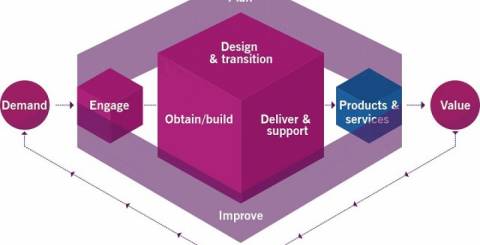Stop Reacting, Start Planning: Why ITIL matters

You wouldn’t build a house without a blueprint so why run an IT team without a framework?
In too many companies, IT departments operate on instinct. They solve problems as they occur, patch systems on the fly, and hope the next outage isn’t around the corner. But instinct isn’t a strategy, and hope definitely isn’t a plan. That’s where the Information Technology Infrastructure Library (ITIL) comes in.
When combined with a solid IT Service Management (ITSM) approach, ITIL helps smart IT teams shift from reactive chaos to proactive control. And the best part? You don’t have to be a tech giant to make it work.
What is ITIL, and why should you care?
The Information Technology Infrastructure Library (ITIL) is a framework of best practices designed to help organizations manage their IT services efficiently. It offers a structured approach to delivering IT services that are aligned with business needs.
Think of it as a guidebook for IT teams. ITIL doesn’t tell you which tools to use, but it helps you create processes that actually work. When used alongside IT Service Management (ITSM), which is the broader discipline of managing IT as a service, ITIL helps ensure consistency, reliability, and continual improvement.
From chaos to control: How ITIL supports ITSM
Building structure where there’s none
A lot of IT teams start small. But as the company grows, so do the problems. Suddenly, what used to be a simple support ticket system turns into a maze of requests, outages, and unclear priorities.
This is where ITIL supports your ITSM strategy. It provides clear guidance on core processes like incident management, change management, and service design. Instead of winging it, your team operates with clear procedures and accountability.
Improving the user experience
Better internal processes mean better experiences for end users. With ITIL guiding your ITSM approach, your team can resolve issues faster, communicate more clearly, and prevent problems before they affect the business.
The result? Happier users, fewer disruptions, and an IT team that’s seen as a strategic asset rather than just tech support.
How to get started with ITIL
The idea of implementing a framework might sound intimidating, but you don’t need to do everything at once. Start small. Pick one ITSM process—maybe incident response or service request fulfillment—and apply ITIL principles to improve it.
You can also explore training and certification options to get your team up to speed. Even a basic understanding of ITIL’s service lifecycle can make a huge difference in how your team operates.
ITIL is for everyone
ITIL isn’t just for massive corporations. Whether you’re running a five-person startup or managing a growing mid-sized business, the principles of ITIL can scale to fit your needs. The goal isn’t complexity—it’s clarity and consistency.
Getting started with ITIL (Information Technology Infrastructure Library) involves understanding its core concepts and benefits for IT service management. Begin by learning the ITIL framework through online courses or official guides. Focus on the ITIL 4 Foundation level, which introduces key principles like the Service Value System and continual improvement. Enroll in accredited training programs to gain practical insights. After studying, take the ITIL Foundation certification exam to validate your knowledge. Implement small-scale ITIL practices in your organization to build experience.
Final thoughts
Don’t wait for a major outage to realize your IT processes need structure. With the Information Technology Infrastructure Library (ITIL) and a thoughtful IT Service Management (ITSM) approach, your team can stop reacting to problems and start preventing them.
ITIL won’t do the work for you, but it will show you how to do it better. And in the world of IT, that’s the kind of edge that makes all the difference.
Similar Articles
Today, modern businesses face constant pressure to operate with maximum efficiency. This requires a technology infrastructure that is both agile and robust. However, the traditional model of on-premises data centers often has significant limitations. These legacy systems can drain valuable resources from teams.
When people are hungry, standing in line for a table feels tiring and unpleasant. In fact, research shows that most individuals will just walk away if they have to wait longer. They will go and find another place to eat.
In the early stages of designing new community centers, fire stations and administration buildings, city planners and architects are forced to make a crucial decision: What building material is best suited for providing the most value, safety and longevity to the public?
Amazon Simple Queue Service (SQS), Simple Notification Service (SNS), and EventBridge are just a few of the messaging services that AWS provides to meet various demands when it comes to creating scalable and effective cloud systems.
Wearable technology, embracing devices small enough to be worn unobtrusively, constitutes a market that keeps expanding, and the momentum shows little sign of slowing
For job seekers, grasping the basic functions of Applicant Tracking Systems (ATS) is the first step in overcoming common job search barriers.
In the highly regulated world of pharmaceutical manufacturing, inventory management is far more than just tracking stock levels. It’s a critical component of ensuring product safety, quality, and compliance with current Good Manufacturing Practices (cGMP)
Find a reliable sealing technology with these 7 tips on quality, materials, certifications, and scalability to ensure lasting performance in your industry.
These days, your business depends on strong telecom systems and well-built software to stay ahead. Whether you’re launching a digital product or improving your communication tools, choosing the right team to work with makes a big difference.









